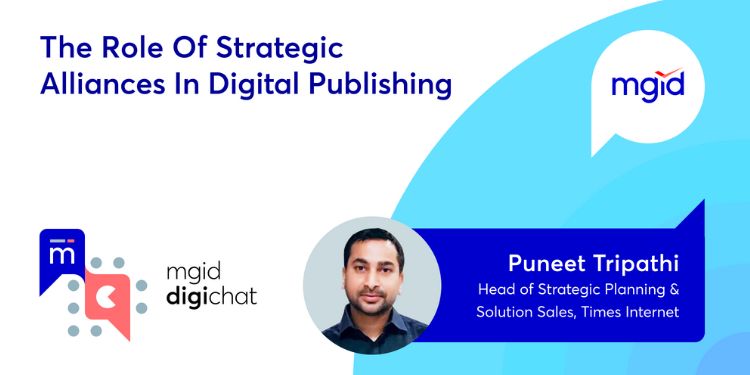Alliances and partnerships are a key staple for business organizations, regardless of their size and scale of operations. Strategic alliances allow enterprises to leverage each other’s strengths, and in the digital publishing world, such alliances prove beneficial for all the parties involved. In the case of Ad Tech companies, strategic alliances with publishers enable them to gain access to publishers’ first party audiences and high-quality content, while publishers gain better monetization rates for their ad inventories.
In addition to better rates, digital publishers experience a host of other benefits from strategic partnerships. Some of which include access to interactive and innovative ad formats that help improve user experience on the website; opportunities to sell analysis and insights into audience behavior to strategic partners; and even the ability to play a key role in the development and promotion of new products.
To discuss the role of strategic alliances in digital publishing, Pankaj Sharma, CEO & Director, MGID India, joins Puneet Tripathi, Head of Strategic Planning & Solution Sales, Times Internet.
Below, you will find a few excerpts from their discussion.
Pankaj Sharma: Why do publishers seek third-party solutions? What issues are publishers addressing with their help?
Puneet Tripathi: Third party solutions, in the context of publishers, generally refers to a third-party ad server. The third-party ad server is a web server that hosts ads and helps publishers to deliver them directly to websites and mobile devices.
Publishers employ third-party servers for campaign and creative management, targeting, ad optimization and campaign analytics. They also use third party ad servers to host their ads, manage the ad inventory and connect to third parties. The latter enables publishers to serve ads on remnant inventory or traffic, with applied third-party ad tags, which allows publishers to fetch ads as and when required.
Using third party solutions simplifies the ad serving process and connects demand partners to a single platform. This tends to prevent data discrepancy in ad reporting and provides real time analytics of ad campaign performance. Ad campaigns can thus be optimized and run with a granular level of reporting.
Pankaj Sharma: What are the main criteria for choosing partners?
Puneet Tripathi: The first thing to keep in mind when choosing partners is evaluating the benefits that both parties will receive out of the agreement. In the case when a publisher and an AdTech company are forming an alliance, then the agreement should be based on the exchange of audience and monetizable inventory. Another important factor is whether the strategic alliance can provide a competitive advantage. To be able to ascertain this, the company should set clear goals and evaluate how the proposed alliance benefits them and what are the risks involved. One needs to remember that every alliance requires on-going contributions in strategic areas.
Other factors that play a significant role in choosing the right partner are experience, vision, reliability, cost advantage and access to technology or resources.
Pankaj Sharma: What is needed to build a partnership that delivers value on both sides?
Puneet Tripathi: Partnering with an experienced and reliable company is one of the most effective ways to expand one’s own reach, but as mentioned earlier, a strategic alliance is successful only when both partners are able to derive benefits from it.
At the beginning of the alliance, both parties should set clear expectations, no matter how strong a bond they may share. The proposed business structure, with action items, and the roles and responsibilities need to be clearly defined. There should be no room for ambiguity. This helps drive better results and measure performance against expectations. Both partners should consider each other as a part of a team. As such, both parties should be involved in the decision-making process, and there should be complete transparency in communication. The last — and perhaps a forward-looking thought — would be that while the agreement is made at the start of the alliance, there must be sufficient room for the partnership to grow as the businesses grow. This way, both partners can ensure that they each deliver value to one other.
Pankaj Sharma: What constitutes an effective partnership and how do you measure its effectiveness?
Puneet Tripathi: One of the most basic explanations of an effective partnership is that both parties are able to achieve the goals they had set for the agreement. If the purpose of the strategic alliance is being met, then it is safe to say that the partnership is effective.
One of the foremost indicators of effectiveness is finance KPIs, i.e., measuring the monetary value or benefits of the strategic alliance. These types of metrics also measure partner performance and sometimes attract potential partners who are interested in a strategic agreement.
More metrics are the number of deals closed on the back of the strategic alliance or the close ratio and leads generated. Some strategic KPIs that evaluate effectiveness are partner experience, partner engagement and satisfaction of the clients or customers onboarded during the alliance.
Pankaj Sharma: What role does technology play in partnerships?
Puneet Tripathi: One of the main reasons why companies enter into strategic alliances is to share and benefit from each other’s technological expertise. Technology is a huge driver in determining when to enter into a strategic alliance and whom to enter into partnership with. Strategic alliances play an important role in technological expansion.
In the fast-moving world of technology, partnership announcements are more frequent, with thousands of start-ups and solution providers forming new alliances to promote exploratory technology or design better technical solutions to solve problems for different industries.
About the guest:
Puneet Tripathi is the Head of Strategic Planning & Solution Sales at Times Internet for Indirect Revenues. He has 15 years of diverse experience in the Internet & Media Industry, focusing on programmatic, strategic partnerships, digital advertising sales, business development and revenue generation. In the past, he has been responsible for driving revenue growth and strategy for companies like Alibaba and Times Group. In addition, he also has successfully executed a go-to-market strategy and established the sales vertical for well-known start-ups like Vdopia, POKKT Media and Art of Click.
Puneet Tripathi’s expertise is in developing digital strategies & planning, driving revenue growth and managing high-performing teams.
















